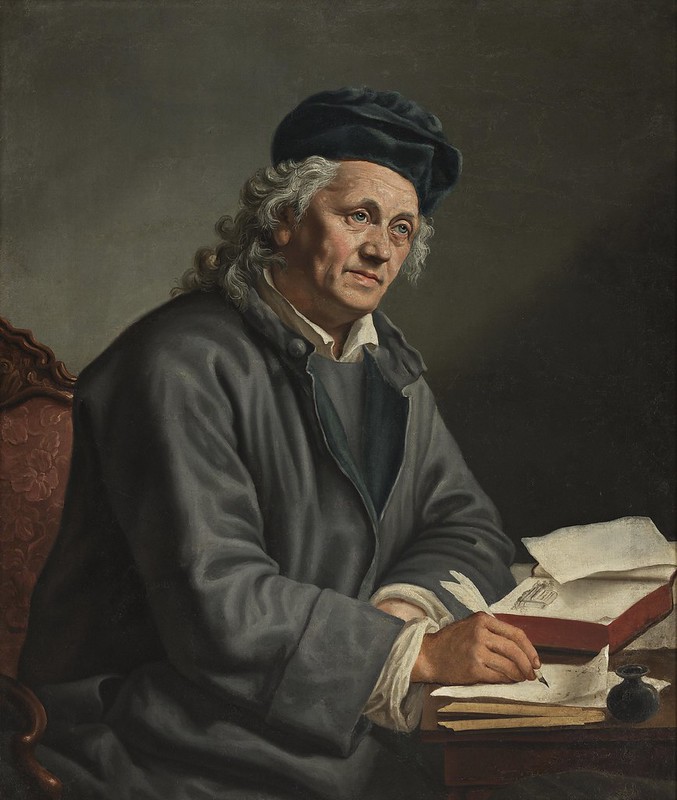Johann Philipp Kirnberger (1721-1783)
- Concerto (c-moll) per il Cembalo Obligato (c.1770)
previously attributed to Johann Sebastian Bach
Performers: Luciano Sgrіzzі (1910-1994, cembalo); Orchestre Jean-François Pаllаrd
Painting: Christoph Friedrich Reinhold Lisiewski (1725-1794) - Portrait of Johann Philipp Kirnberger
Further info: Johann Philipp Kirnberger (1721-1783) - Flotensonaten
---
German theorist and composer. All information relating to his career
before 1754 is based on F.W. Marpurg’s biographical sketch (1754), an
autograph album described by Max Seiffert (1889) and comments found in
letters Kirnberger wrote to J.N. Forkel in the late 1770s. He received
his earliest training on the violin and harpsichord at home, and
attended grammar school in Coburg and possibly Gotha. He studied the
organ with J.P. Kellner in Gräfenroda before 1738, and then the violin
with a musician named Meil and the organ with Heinrich Nikolaus Gerber
in Sondershausen in 1738. According to Marpurg, Kirnberger went in 1739
to Leipzig, where he studied composition and performance with Bach for
two years (the autograph book shows that he was in Sondershausen in 1740
and Leipzig in 1741, which does not preclude his period of study with
Bach). In June 1741 Kirnberger travelled to Poland, where he spent the
next ten years in the service of various Polish noblemen. He also held a
position as music director at the Benedictine convent at
Reusch-Lemberg. In 1751 Kirnberger returned to Germany apparently
stopping at Coburg and Gotha before going to Dresden, where he studied
the violin for a short time. He was then engaged by the Prussian royal
chapel in Berlin as a violinist. By 1754 he had resigned that post and
obtained permission to join the chapel of Prince Heinrich of Prussia,
and in 1758 was given leave to enter the service of Princess Anna Amalia
of Prussia, a position he retained to the end of his life. Kirnberger
was among the most significant of a remarkable group of theorists,
centred in Berlin, which included J.J. Quantz, C.P.E. Bach and Marpurg.
Almost without exception his contemporaries described him as emotional
and ill-tempered, but dedicated to the highest musical standards.
Criticized for being inflexible, conservative, tactless, and even
pedantic, his detractors still acknowledged his devotion to his students
and friends. These included his employer Princess Anna Amalia (whose
famous library he helped to assemble), and such eminent musicians as
C.P.E. Bach, J.F. Agricola, the Graun brothers, J.A.P. Schulz (his most
important pupil) and the encyclopedist J.G. Sulzer, to whose Allgemeine
Theorie der schönen Künste (1771-74) he contributed articles. Most
accounts agree that he was a middling performer and that his
compositions were correct if uninspired. Many are in a galant style
similar to that of C.P.E. Bach; others are in the older ‘strict’ style
in the manner of J.S. Bach, but in neither category does Kirnberger
display the harmonic or melodic imagination of his models. Although his
musical knowledge was wide and profound, it was, according to his
contemporaries, disorganized. He found it so difficult to express his
ideas in writing that he had to call on others to edit or even rewrite
his theoretical works (Die wahren Grundsätze (1773), for example, was
written by J.A.P. Schulz under Kirnberger’s supervision). Nonetheless,
even his most severe critics, such as Marpurg, considered his
theoretical and didactic works to be invaluable. Kirnberger regarded
J.S. Bach as the supreme composer, performer and teacher. He regretted
that Bach left no didactic or theoretical works and tried through his
own teaching and writing to propagate ‘Bach’s method’. His devotion to
this cause is reflected in 14 years’ intermittent effort to obtain the
publication of all Bach’s four-part chorale settings.

Cap comentari:
Publica un comentari a l'entrada